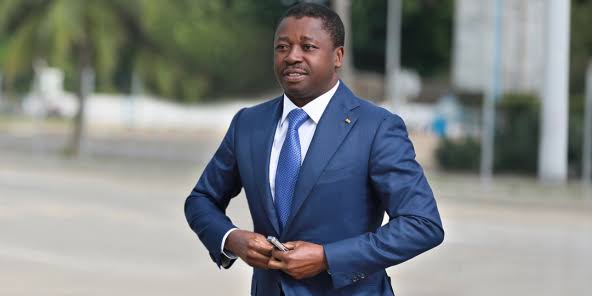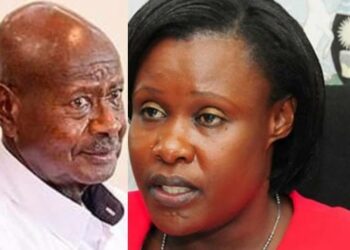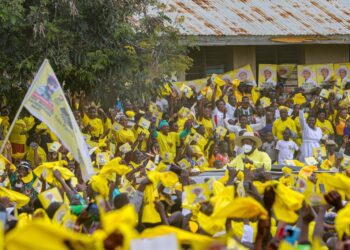On Friday afternoon, the President of the Republic of Togo His Excellency Faure Essozimna Gnassingbe Eyadema arrived in Uganda for an official visit.
President Gnassingbe Eyadema was welcomed by the Minister for Security Gen Jim Muhwezi and is expected to hold bilateral talks with His Excellency President Gen Yoweri Kaguta Museveni.
However, who is President Gnassingbe Eyadema?
President Eyadema was born on June 6, 1966, in Afanyagan, Togo, a year after his father Etienne Gnassingbé Eyadema, an army officer seized power in a military coup that overthrew the government of President Nicolas Grunitzky and his father then became president of Togo.
As the first son, Gnassingbé enjoyed every level of privilege and was educated in Paris at the Sorbonne (part of the Universities of Paris I–XIII), where he studied economics and international relations. He also earned a master’s degree in business administration from George Washington University in Washington, District of Colombia.
After attaining his Master’s degree, he returned to Togo to be part of the management of his family’s business affairs, serving as a financial adviser to his father.
However, when he became his father’s adviser, many observers knew that Etienne was grooming his son to succeed him as president. His participation in June 2002’s elections running for a parliamentary seat as a member of the ruling party of the Togolese People (Rassemblement du Peuple Togolais; RPT) was a confirmatory move that indeed Etienne was preparing his son for the big job.
In that election, Eyadema won a seat for the city of Blitta and later his father appointed him Minister of telecommunications, mines, and equipment. Political observers in Togo say that Eyadema was viewed as a quiet, calm figure and because of this character, he earned respect from the military.
At the end of 2002, President Etienne Eyadema Senior started a move to amend the constitution to lower the eligibility age for the presidency from 40 to 35. However by that time his son Gnassingbé Eyadema junior was 36, and in 2003 the management of presidential elections was transferred from an independent commission to the Ministry of the Interior.
Unfortunately, on February 5, 2006, Eyadema’s father President Etienne Gnassingbé Eyadema died of a heart attack while being flown abroad for medical treatment.
A few days before Eyadema’s death, the President of the National Assembly, Fambare Natchaba Ouattara had travelled to Europe on official assignment as head of a parliamentary delegation. He was in Europe when Eyadema passed away.
His absence helped the army to create a move for Eyadema junior to step in because about two hours later, the Chief of Staff of the Togolese Armed Forces, General Zachari Nandja, appeared on state television flanked by the country’s top army personnel to announce: “The armed forces of Togo find itself [sic] faced with the evidence of a total vacuum of power in Togo. This is because the Speaker of the National Assembly is absent. Therefore, in order not to create a power vacuum, the armed forces of Togo have decided to declare Faure Gnassingbe the head of state.” He concluded, “The Togolese armed forces swear allegiance to Faure Gnassingbe as President of the Republic of Togo.”
At the same time, General Nandja announced the closure of the country’s borders. As a result of this measure, the President of the National Assembly, who was returning home from his trip, was not allowed to re-enter the country. For all intents and purposes, the military thus created the “power vacuum.”
As the Togolese constitution states, Eyadema was not in any line to succeed his father, it was Fambare to fill the space but was not given that chance because the military stepped in and named Eyadema as his father’s successor to the presidency.
However, this coup was denounced throughout Africa and the world. International pressure was applied and Eyadema responded by briefly stepping down. The speaker of parliament, Bonfoh Abass, was appointed interim president until an election could be held in April 2006. Gnassingbé Eyadema was elected president with 60 per cent of the vote.
On May 4, 2006, Gnassingbé Eyadema was installed as president of Togo. His accession to the throne of the presidency, however, was accompanied by violent opposition protests that left hundreds of people dead or injured, and several thousand Togolese fled the country in fear of political persecution.
Despite finding isolated irregularities, the official delegation from the Economic Community of West African States declared the elections free and fair, and the Constitutional Court rejected the claims of opposition leaders that Gnassingbé’s victory at the polls had been rigged.
Since he took the power, he has always been winning elections with margins of about 65 per cent. In his reign, he has changed the constitution several times and it’s one of the major issues that have caused unrest in his country.
Due to pressure, the National Assembly passed the constitutional amendments in May 2019 that included the reinstatement of the limit of two terms for the president but without the retroactive clause, giving Eyadema an option to run in 2020 and 2025, potentially serving as president until 2030.
In 2020 February, Eyadema ran in the election winning more than 70 per cent of the vote.
Do you have a story in your community or an opinion to share with us: Email us at editorial@watchdoguganda.com














